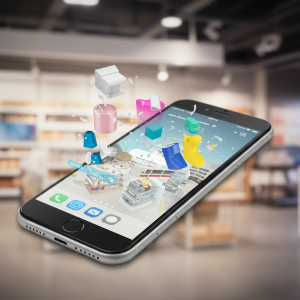Augmented Reality in Mobile Marketing: Crafting Immersive Customer Experiences

In an increasingly competitive digital landscape, brands need innovative ways to capture attention and drive deeper engagement. Augmented reality (AR) has emerged as a game-changing technology that overlays digital content onto the physical world, enabling mobile marketers to deliver interactive, memorable experiences.
Why AR Matters for Modern Mobile Campaigns

Mobile devices have become the primary gateway for consumers to discover and interact with brands. AR leverages the hardware capabilities of smartphones—cameras, sensors, and processing power—to merge virtual elements with real-world environments. This fusion creates a sense of novelty and immersion that outperforms static ads and traditional display formats. By tapping into AR, marketers can:
- Elevate brand storytelling through interactive content
- Increase dwell time and social shares
- Provide hands-on product trials without physical inventory
- Collect valuable user behavior data in real time
Top AR Use Cases in Mobile Marketing
From e-commerce to entertainment, AR has wide applications across industries. Here are the leading use cases driving results today:
1. Virtual Try-On Experiences
Beauty and fashion brands let users virtually apply makeup, sunglasses, or clothing via their device cameras. This reduces purchase hesitation and returns by giving shoppers confidence in fit and style. Popular examples include AR mirrors in retail stores and in-app 3D visualization tools.
2. Interactive Product Demos
Consumer electronics companies use AR to let customers place life-size 3D models of furniture, appliances, and gadgets in their homes. This contextualizes size, aesthetics, and functionality before purchase, boosting conversion rates and lowering returns.
3. Location-Based AR Campaigns
Brands deploy geo-triggered AR experiences tied to real-world landmarks or points of sale. For example, a restaurant chain might overlay a digital menu when users hover their phone near a storefront, or a theme park app can animate characters walking around on your screen.
Best Practices for AR Mobile Marketing
Successfully leveraging AR requires thoughtful planning and execution. Follow these best practices to ensure your campaign resonates with audiences and meets business goals:
- Focus on Utility: Prioritize experiences that solve real user problems or add genuine value, rather than gimmicks.
- Ensure Smooth Performance: Optimize 3D assets and code to minimize load times, battery drain, and crashes across iOS and Android devices.
- Promote Social Sharing: Include built-in sharing buttons and encourage users to post their AR experiences to amplify reach organically.
- Use Clear CTAs: Guide users through the experience with on-screen prompts, and end with a strong call to action—download, purchase, or visit in-store.
- Measure Engagement Metrics: Track dwell time, repeat usage, shares, and conversions to evaluate ROI and iterate on future AR campaigns.
Choosing the Right AR Technology Stack
Several AR development platforms can accelerate your mobile projects, each with unique strengths:
- ARKit (iOS): Apple’s framework delivers high-fidelity tracking and 3D object detection for iPhone and iPad apps.
- ARCore (Android): Google’s AR toolkit provides robust motion tracking, environmental understanding, and light estimation.
- Unity & Unreal Engine: Popular game engines that support cross-platform AR experiences with advanced graphics capabilities.
- WebAR Platforms: Tools like 8th Wall and ZapWorks deliver browser-based AR without requiring app downloads, ideal for low-friction campaigns.
Measuring Success: KPIs for AR Campaigns
To prove the value of AR, track these key performance indicators:
- Engagement Rate: Percentage of users who launch and complete the AR experience.
- Average Session Duration: Time spent interacting with AR content.
- Social Shares: Number of in-app generated posts across social channels.
- Conversion Lift: Increase in purchases or sign-ups attributed to AR interactions.
- Return on Ad Spend (ROAS): Revenue directly tied to AR campaign investment.
Overcoming Common AR Challenges
Implementing AR can be complex. Anticipate and address these hurdles early:
- Hardware Fragmentation: Test on a broad range of devices to ensure compatibility and consistent experience.
- Content Production Costs: Use modular 3D assets and leverage off-the-shelf libraries to reduce time and budget requirements.
- User Privacy Concerns: Be transparent about camera access and data usage, and follow GDPR/CCPA guidelines.
- Discoverability: Promote your AR feature via social media teasers, push notifications, and QR codes in physical locations.
Future Trends in Mobile AR Marketing

As AR matures, expect these trends to reshape mobile marketing:
- Persistent AR: Experiences that stay anchored in real-world locations and persist across sessions.
- AI-Driven Interactions: Smarter object recognition and context-aware content powered by machine learning.
- Social AR Collaboration: Multi-user AR spaces where friends can interact digitally in the same physical room.
- 5G-Enabled Rich Media: Real-time streaming of high-fidelity 3D objects and video overlays with low latency.
Getting Started: A Step-By-Step AR Roadmap
Begin your AR journey with this roadmap:
- Define Objectives: Identify target audience, key messages, and desired outcomes (e.g., sales lift, downloads).
- Select Use Case: Choose an AR scenario that aligns with your product and audience needs.
- Partner with Experts: Collaborate with AR developers or agencies experienced in mobile campaigns.
- Develop & Test: Build a minimum viable AR experience, conduct beta tests, and iterate based on feedback.
- Launch & Promote: Use omnichannel promotion—email, social media, in-app push, and QR codes.
- Measure & Optimize: Analyze KPIs, gather user insights, and refine the experience for future versions.
Conclusion
Augmented reality represents a powerful frontier for mobile marketing, offering unmatched opportunities to captivate audiences and differentiate your brand. By focusing on user value, choosing the right technology, and rigorously measuring performance, you can craft AR campaigns that not only drive engagement but also deliver measurable business results. Start small, learn fast, and scale strategically to harness the full potential of AR in your next mobile marketing initiative.
Ready to elevate your mobile marketing with augmented reality? Begin planning your first AR experience today and stay ahead in the age of immersive digital engagement.





